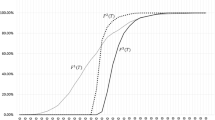Abstract
This paper presents a two-stage multi-period decision model for allocation of the individual's savings into several investment plans. Although the U.S. economy is used as the background, the modelling methods are general enough to accommodate any tax law. The first stage of the model uses an asset-allocation method based on the single-index model. Because this method is static and does not provide for tax considerations and other constraints, it alone is not enough. The output of this optimal selection is used as exogenous parameters and controls for the second stage of the model which is an integer program. The IP includes fixed charges, statutory and budgetary constraints, a discount rate, and the risk level. We provide an example of this approach to illustrate how an individual can achieve his goals of terminal accumulations while maintaining the risk level, measured by the aggregate beta, he prefers. A linear programming relaxation of the IP model is utilized for sensitivity analysis to examine whether future adjustments in investment strategies are required. The model remains tractable enough for implementation by individuals who may not be experts in mathematical programming and financial planning.
Similar content being viewed by others
References
S.W. Adelman and M.S. Dorfman, A comparison of TDA and non-TDA investment returns, J. Risk Ins. 49 (1982) 73–90.
B.M. Bradford and P. Lee, Investigation of cost variances within a linear programming framework, Working Paper: La Salle University (1992).
D.P. Brown, Multiperiod financial planning, Manag. Sci. 33 (1987) 848–875.
E.J. Elton, M.J. Gruber and M.W. Padberg, Simple criteria for optimal portfolio selection, J. Fin. 31 (1976) 1341–1357.
E.F. Fama, Multiperiod consumption-investment decisions, Amer. Econ. Rev. 60 (1970) 163–174.
F.S. Gahin, The financial feasibility of tax-sheltered individual retirement plans, J. Risk Ins. 50 (1983) 84–106.
N.H. Hakansson, Optimal investment and consumption strategies under risk for a class of utility functions, Econometrica 38 (1970) 587–607.
R.C. Healy, Jr., An economic analysis of tax sheltered annuities for employees of non-profit organizations, J. Ins. Issues Prac. 5 (1981) 43–49.
D. Levhari and T.N. Srinivasan, Optimal savings under uncertainty, Rev. Econ. Stud. 36 (1969) 153–163.
H.M. Markowitz, Portfolio selection, J. Fin. 7 (1952) 77–91.
H.M. Markowitz,Portfolio Selection: Efficient Diversification of Investment (Wiley, New York, 1959).
R.C. Merton, Optimum consumption and portfolio rules in a continuous time model, J. Econ. Theory 3 (1971) 373–413.
F. Modigliani and R. Brumberg, Utility analysis and the consumption function: An interpretation of cross-section data, in:Post-Keynesian Economics, ed. K.K. Kurihara (Rutgers University Press, New Brunswick, NJ, 1954) pp. 388–436.
T.B. Morehart and G.L. Trennepohl, Evaluating the tax-sheltered annuity vs. the taxed investment, CLU J. 33 (1979) 23–30.
J. Mossin, Optimal multiperiod portfolio policies, J. Bus. 41 (1968) 215–229.
E.S. Phelps, The accumulation of risky capital: A sequential utility analysis, Econometrica 30 (1962) 729–743.
R.C. Radcliffe,Investment: Concepts, Analysis, Strategy (Scott, Foresman, Glenview, IL, 1990).
P.A. Samuelson, Lifetime portfolio selection by dynamic stochastic programming, Rev. Econ. Stat. 51 (1969) 239–246.
W.F. Sharpe, Simple strategies for portfolio diversification: Comment, J. Fin. 7 (1972) 127–129.
W.F. Sharpe, Simple strategies for portfolio diversification: Comment, A Correction, J. Fin. 7 (1972) 733.
W.F. Sharpe,AAT: Asset Allocation Tools (Scientific Press, Palo Alto, CA, 1985).
J.D. Todd, The retirement funding decision: Tax-sheltered annuities vs. alternatives, J. Ins. Issues Prac. 2 (1978) 69–80.
New incentives for saving is slated to be proposed by White House, Wall Street Journal 121 (117), A3 (Friday, December 15, 1989).
Author information
Authors and Affiliations
Rights and permissions
About this article
Cite this article
Lee, P.S., Vora, G. A two-stage approach to multi-period allocation of savings among investment plans. Ann Oper Res 45, 221–242 (1993). https://doi.org/10.1007/BF02282051
Issue Date:
DOI: https://doi.org/10.1007/BF02282051




